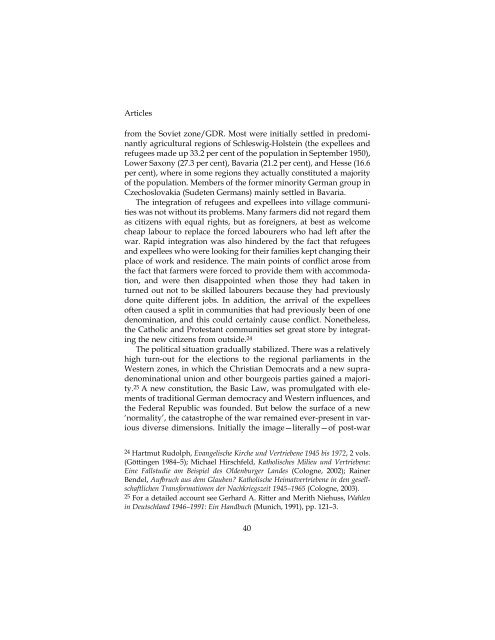Download - German Historical Institute London
Download - German Historical Institute London
Download - German Historical Institute London
You also want an ePaper? Increase the reach of your titles
YUMPU automatically turns print PDFs into web optimized ePapers that Google loves.
Articles<br />
from the Soviet zone/GDR. Most were initially settled in predominantly<br />
agricultural regions of Schleswig-Holstein (the expellees and<br />
refugees made up 33.2 per cent of the population in September 1950),<br />
Lower Saxony (27.3 per cent), Bavaria (21.2 per cent), and Hesse (16.6<br />
per cent), where in some regions they actually constituted a majority<br />
of the population. Members of the former minority <strong>German</strong> group in<br />
Czechoslovakia (Sudeten <strong>German</strong>s) mainly settled in Bavaria.<br />
The integration of refugees and expellees into village communities<br />
was not without its problems. Many farmers did not regard them<br />
as citizens with equal rights, but as foreigners, at best as welcome<br />
cheap labour to replace the forced labourers who had left after the<br />
war. Rapid integration was also hindered by the fact that refugees<br />
and expellees who were looking for their families kept changing their<br />
place of work and residence. The main points of conflict arose from<br />
the fact that farmers were forced to provide them with accommodation,<br />
and were then disappointed when those they had taken in<br />
turned out not to be skilled labourers because they had previously<br />
done quite different jobs. In addition, the arrival of the expellees<br />
often caused a split in communities that had previously been of one<br />
denomination, and this could certainly cause conflict. Nonetheless,<br />
the Catholic and Protestant communities set great store by integrating<br />
the new citizens from outside. 24<br />
The political situation gradually stabilized. There was a relatively<br />
high turn-out for the elections to the regional parliaments in the<br />
Western zones, in which the Christian Democrats and a new supradenominational<br />
union and other bourgeois parties gained a majority.<br />
25 A new constitution, the Basic Law, was promulgated with elements<br />
of traditional <strong>German</strong> democracy and Western influences, and<br />
the Federal Republic was founded. But below the surface of a new<br />
‘normality’, the catastrophe of the war remained ever-present in various<br />
diverse dimensions. Initially the image—literally—of post-war<br />
24 Hartmut Rudolph, Evangelische Kirche und Vertriebene 1945 bis 1972, 2 vols.<br />
(Göttingen 1984–5); Michael Hirschfeld, Katholisches Milieu und Vertriebene:<br />
Eine Fallstudie am Beispiel des Oldenburger Landes (Cologne, 2002); Rainer<br />
Bendel, Aufbruch aus dem Glauben? Katholische Heimatvertriebene in den gesellschaftlichen<br />
Transformationen der Nachkriegszeit 1945–1965 (Cologne, 2003).<br />
25 For a detailed account see Gerhard A. Ritter and Merith Niehuss, Wahlen<br />
in Deutschland 1946–1991: Ein Handbuch (Munich, 1991), pp. 121–3.<br />
40













